Notizie per Categorie
Articoli Recenti
- [In preview] Public Preview: Azure Blob-to-Blob migration made simple with Azure Storage Mover 18 Dicembre 2025
- AI transformation in financial services: 5 predictors for success in 2026 18 Dicembre 2025
- New Microsoft e-book: 3 reasons point solutions are holding you back 18 Dicembre 2025
- [In preview] Public Preview: Service Bus SDK type bindings in Azure Functions for Node.js 17 Dicembre 2025
- [Launched] Generally Avaailable: Azure SQL updates for early December 2025 17 Dicembre 2025
- [In preview] Public Preview: Use Azure SRE Agent with Azure Cosmos DB 17 Dicembre 2025
- Access Fabric: A modern approach to identity and network access 17 Dicembre 2025
- [In preview] Generally Available: Azure NetApp Files cross-zone-region replication (CZRR) 16 Dicembre 2025
- [In preview] Public Preview: Azure NetApp Files advanced ransomware protection 16 Dicembre 2025
- Defending against the CVE-2025-55182 (React2Shell) vulnerability in React Server Components 15 Dicembre 2025
IoT devices and Linux-based systems targeted by OpenSSH trojan campaign
Cryptojacking, the illicit use of computing resources to mine cryptocurrency, has become increasingly prevalent in recent years, with attackers building a cybercriminal economy around attack tools, infrastructure, and services to generate revenue from targeting a wide range of vulnerable systems, including Internet of Things (IoT) devices. Microsoft researchers have recently discovered an attack leveraging custom and open-source tools to target internet-facing Linux-based systems and IoT devices. The attack uses a patched version of OpenSSH to take control of impacted devices and install cryptomining malware.
Utilizing an established criminal infrastructure that has incorporated the use of a Southeast Asian financial institution’s subdomain as a command and control (C2) server, the threat actors behind the attack use a backdoor that deploys a wide array of tools and components such as rootkits and an IRC bot to steal device resources for mining operations. The backdoor also installs a patched version of OpenSSH on affected devices, allowing threat actors to hijack SSH credentials, move laterally within the network, and conceal malicious SSH connections. The complexity and scope of this attack are indicative of the efforts attackers make to evade detection.
In this blog post, we present our analysis of the tools and techniques used in this attack and the efforts made by the threat actor to evade detection on affected devices. We also provide indicators of compromise and relevant Microsoft Defender for IoT and Microsoft Defender for Endpoint detections, as well as recommendations for defenders to protect devices and networks.
Attack chain
The threat actors initiate the attack by attempting to brute force various credentials on misconfigured internet-facing Linux devices. Upon compromising a target device, they disable shell history and retrieve a compromised OpenSSH archive named openssh-8.0p1.tgz from a remote server. The archive contains benign OpenSSH source code alongside several malicious files: the shell script inst.sh, backdoor binaries for multiple architectures (x86-64, arm4l, arm5l, i568, and i686), and an archive containing the shell script vars.sh, which holds embedded files for the backdoor’s operation.
After installing the payload, the shell script inst.sh runs a backdoor binary that matches the target device’s architecture. The backdoor is a shell script compiled using an open-source project called Shell Script Compiler (shc), and enables the threat actors to perform subsequent malicious activities and deploy additional tools on affected systems.
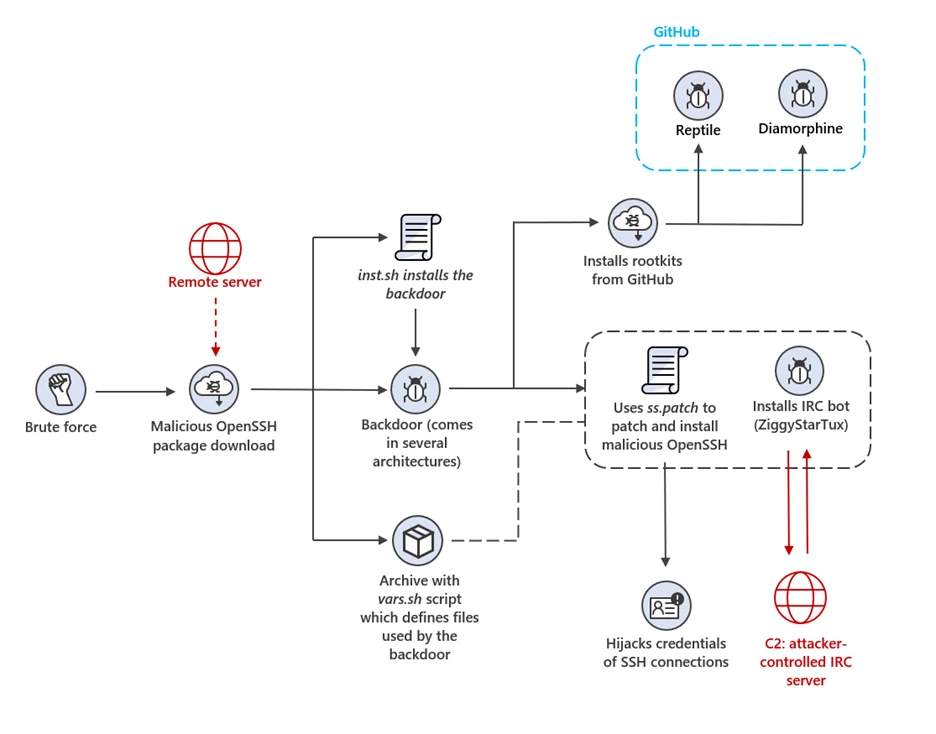
Custom backdoor deploys open-source rootkits
Once running on a device, the shell script backdoor tests access to /proc to determine whether the device is a honeypot. If it can’t access /proc, it determines the device is a honeypot and exits. Otherwise, it exfiltrates information about the device, including its operating system version, network configuration, and the contents of /etc/passwd and /etc/shadow over email to the hardcoded address dotsysadmin[@]protonmail[.]com, and to any email address provided by the threat actor as an argument to the script.
On supported systems, the backdoor downloads, compiles, and installs two open-source rootkits available on GitHub, Diamorphine and Reptile. The backdoor configures Reptile to connect to the C2 domain rsh.sys-stat[.]download on port 4444 and to hide its child processes, files, or their content. Microsoft researchers assess that the Diamorphine rootkit is used to hide processes as well.
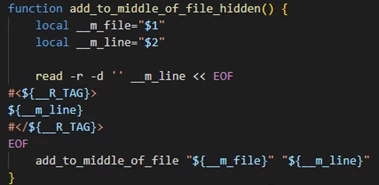
To ensure persistent SSH access to the device, the backdoor appends two public keys to the authorized_keys configuration files of all users on the system.
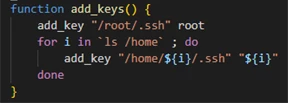
The backdoor obscures its activity by removing records from Apache, nginx, httpd, and system logs that contain the IP and username specified as arguments to the script. Additionally, it has the capability to install an open-source utility called logtamper to clear the utmp and wtmp logs, which record information about user sign-in sessions and system events.
The backdoor eliminates cryptomining competition from other miners that may exist on the device by monopolizing device resources and preventing communication with a hardcoded list of hosts and IPs related to these activities. It accomplishes this by adding iptables rules to drop communication with the hosts and IPs and configuring /etc/hosts to make the hosts resolve to the localhost address. It also identifies miner processes and files by their names and either terminates them or blocks access to them, and removes SSH access configured in authorized_keys by other adversaries.
Patching OpenSSH source code
The backdoor uses the Linux patch utility to apply the patch file ss.patch, which is embedded in vars.sh, to the OpenSSH source code files included in its package. Once the patches are applied, the backdoor compiles and installs the modified OpenSSH on the device.
The compromised OpenSSH grants the attackers persistent access to the device and to the SSH credentials the device handles. The patches install hooks that intercept the passwords and keys of the device’s SSH connections, whether as a client or a server. The passwords and keys are then stored encrypted in a file on the disk. Moreover, the patches enable root login over SSH and conceal the intruder’s presence by suppressing the logging of the threat actors’ SSH sessions, which are distinguished by a special password.
The modified version of OpenSSH mimics the appearance and behavior of a legitimate OpenSSH server and may thus pose a greater challenge for detection than other malicious files. The patched OpenSSH could also enable the threat actors to access and compromise additional devices. This type of attack demonstrates the techniques and persistence of adversaries who seek to infiltrate and control exposed devices.
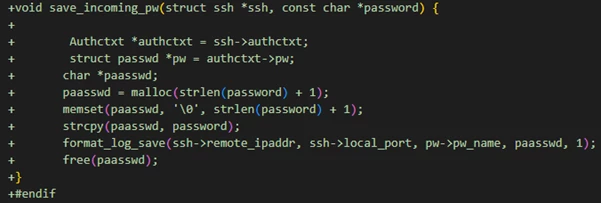
Botnet operation
The backdoor runs a secondary payload embedded in the shell script vars.sh, which is a slightly modified version of ZiggyStarTux, an open-source IRC bot based on the Kaiten malware. Among its features is executing bash commands issued from the C2 and possessing distributed denial of service (DDoS) capabilities.
The backdoor employs various mechanisms to set up ZiggyStarTux’s persistence on compromised systems. It copies the ZiggyStarTux binary to several locations on the disk and establishes cron jobs to invoke it at regular intervals. Moreover, it runs a bash script that registers ZiggyStarTux as a systemd service by creating and configuring the service file /etc/systemd/system/network-check.service.
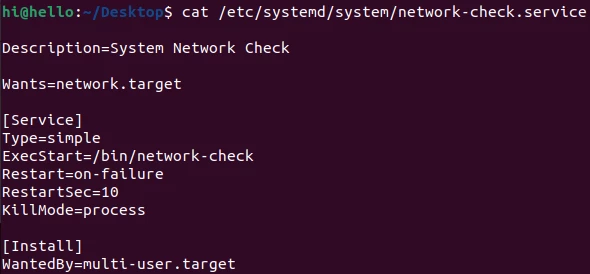
Analysis of ZiggyStarTux revealed that the threat actors stripped the binary of logging-related strings and incorporated a function that writes the bot’s process ID to /var/run/sys_checker.pid, allowing the backdoor to read that file and conceal that process ID using the installed rootkits.
The ZiggyStarTux bots communicate with the C2 via an IRC server hosted on various domains and IPs located in different geographical regions. Evidence indicates that the threat actors disguise their traffic by utilizing the subdomain of a Southeast Asian financial institution that is hosted on one of their own servers.
To receive commands, the ZiggyStarTux bots connect to the IRC server and join a hidden password-protected channel named ##..##. The server was observed issuing bash commands that instruct bots to download and launch two shell scripts from a remote server. The first script, lscan, retrieves lssh.tgz from the server, an archive of scripts that scan each IP in the subnet for SSH access using a password list. The scripts record the results of each connection attempt in a log file.
The second script, zaz, fetches the compromised OpenSSH package with the embedded backdoor from the remote server. The installation is carried out using the email address ancientgh0st@yahoo[.]com as an argument to serve as an additional exfiltration point for device information. Additionally, zaz retrieves an archive called hive-start.tgz which contains mining malware crafted for Hiveon OS systems, a Linux-based open-source operating system designed for cryptomining.
Indications of criminal cooperation
Microsoft researchers have traced the campaign to a user named asterzeu on the hacking forum cardingforum[.]cx, who offered multiple tools for sale on the platform, including an SSH backdoor. The domain madagent[.]tm was registered in 2015 with an email address matching the username and shared numerous servers over a four-year period with madagent[.]cc, one of the C2 domains of ZiggyStarTux. Furthermore, the distribution of the shell script backdoor between threat actors has been identified, adding to the evidence of a network of tools and infrastructure shared or sold on the malware-as-a-service market.
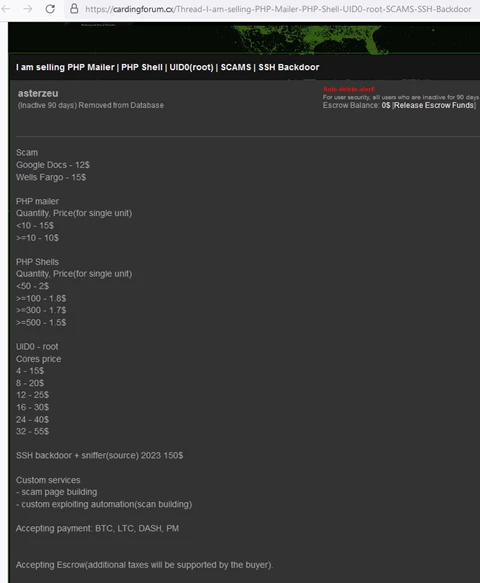
Mitigation and protection guidance
Microsoft recommends the following steps to protect devices and networks against this threat:
- Harden internet-facing devices against attacks
- Ensure secure configurations for devices: Change the default password to a strong one, and block SSH from external access.
- Maintain device health with updates: Make sure devices are up to date with the latest firmware and patches.
- Use least-privileges access: Use a secure virtual private network (VPN) service for remote access and restrict remote access to the device.
- When possible, update OpenSSH to the latest version.
- Adopt a comprehensive IoT security solution such as Microsoft Defender for IoT to allow visibility and monitoring of all IoT and OT devices, threat detection and response, and integration with SIEM/SOAR and XDR platforms such as Microsoft Sentinel and Microsoft 365 Defender.
- Use security solutions with cross-domain visibility and detection capabilities like Microsoft 365 Defender, which provides integrated defense across endpoints, identities, email, applications, and data.
Detections
Microsoft Defender for IoT
Microsoft Defender for IoT uses detection rules and signatures to identify malicious behavior. Microsoft Defender for IoT has alerts for the use of open-source tools and exploits that may be tied to this attack.
Microsoft Defender Antivirus
Microsoft Defender Antivirus detects this threat as the following malware:
- Trojan:Linux/SamDust!MTB
- Trojan:Linux/SamDust.D!MTB
- Trojan:Linux/SamDust.B!MTB
- Trojan:Linux/SamDust.A!MTB
- Trojan:Linux/SamDust.N!MTB
- Trojan:Linux/Reptile.A
- Trojan:Linux/Reptile.B
- Trojan:Linux/Reptile.C
- Trojan:Linux/Reptile.D
- Trojan:Linux/Diamorphine.A!MTB
Microsoft Defender for Endpoint
The following Microsoft Defender for Endpoint alerts can indicate associated threat activity:
- Unusual number of failed sign-in attempts
The following alerts might also indicate threat activity related to this threat. Note, however, that these alerts can be also triggered by unrelated threat activity.
- Suspicious file property modification occurred
- Suspicious termination of security tool
- Suspicious service launched
- Suspicious Linux service created
- File masquerading
Hunting queries
Microsoft Sentinel
Microsoft Sentinel customers can use the TI Mapping analytics (a series of analytics all prefixed with ‘TI map’) to automatically match the malicious domain indicators mentioned in this blog post with data in their workspace. If the TI Map analytics are not currently deployed, customers can install the Threat Intelligence solution from the Microsoft Sentinel Content Hub to have the analytics rule deployed in their Sentinel workspace. More details on the Content Hub can be found here: https://learn.microsoft.com/azure/sentinel/sentinel-solutions-deploy.
In addition, customers can use the SSH Brute force detection template in the Syslog solution package to monitor for brute force attempts against their exposed SSH endpoints.
Indicators of Compromise
| Indicator | Type |
| asterzeu[@]yahoo[.]com | Email address |
| dotsysadmin[@]protonmail[.]com | Email address |
| 185.161.208[.]234 | C2 |
| 139.180.185[.]24 | C2 |
| 199.247.30[.]230 | C2 |
| 149.28.239[.]146 | C2 |
| 209.250.234[.]77 | C2 |
| 70.34.220[.]100 | C2 |
| irc[.]socialfreedom[.]party | C2 |
| singapore[.]sg[.]socialfreedom[.]party | C2 |
| amsterdam[.]nl[.]socialfreedom[.]party | C2 |
| frankfurt[.]de[.]socialfreedom[.]party | C2 |
| sidney[.]au[.]socialfreedom[.]party | C2 |
| losangeles[.]us[.]socialfreedom[.]party | C2 |
| mumbaitravelers[.]org | C2 |
| sh[.]madagent[.]tm | C2 |
| ssh[.]madagent[.]tm | C2 |
| dumpx[.]madagent[.]tm | C2 |
| reg[.]madagent[.]tm | C2 |
| sshm[.]madagent[.]tm | C2 |
| z[.]madagent[.]tm | C2 |
| ssho[.]madagent[.]tm | C2 |
| sshr[.]madagent[.]tm | C2 |
| sshu[.]madagent[.]tm | C2 |
| user[.]madagent[.]tm | C2 |
| madagent[.]cc | C2 |
| cler[.]madagent[.]cc | C2 |
| dumpx[.]madagent[.]cc | C2 |
| mh[.]madagent[.]cc | C2 |
| ns1[.]madagent[.]cc | C2 |
| ns2[.]madagent[.]cc | C2 |
| ns3[.]madagent[.]cc | C2 |
| ns4[.]madagent[.]cc | C2 |
| reg[.]madagent[.]cc | C2 |
| ssh[.]madagent[.]cc | C2 |
| sshm[.]madagent[.]cc | C2 |
| ssho[.]madagent[.]cc | C2 |
| sshr[.]madagent[.]cc | C2 |
| sshu[.]madagent[.]cc | C2 |
| user[.]madagent[.]cc | C2 |
| www[.]madagent[.]cc | C2 |
| rsh[.]sys-stat[.]download | C2 |
| sh[.]sys-stat[.]download | C2 |
| sh[.]rawdot[.]net | C2 |
| ssho[.]rawdot[.]net | C2 |
| donate[.]xmr[.]rawdot[.]net | C2 |
| pool[.]rawdot[.]net | C2 |
| 2018[.]rawdot[.]net | C2 |
| blog[.]rawdot[.]net | C2 |
| clients[.]rawdot[.]net | C2 |
| ftp[.]rawdot[.]net | C2 |
| psql01[.]rawdot[.]net | C2 |
| www[.]rawdot[.]net | C2 |
| sh[.]0xbadc0de[.]stream | C2 |
| ss[.]0xbadc0de[.]stream | C2 |
| a26631dcc1aef92a92d2d37476fb1e9becae54541e0411224a441d3afc20b02a | Script to launch ZiggyStarTux |
| 6e9b692b401a57db306bd6c95409042aa6ed075088a40a6ceb74f96895116b62 | ZiggyStarTux |
| 5e11731e570fc79ad07da4f137e103e0ebfa45530fabd8fa9a9fece4e497bce0 | ZiggyStarTux |
| 22c2115becd1d0ff9dfe70d14a52ab0354e420f4bfe0df70ca0d55d3c557c6b3 | ZiggyStarTux |
| d335c83c0dd5bc9a078e796016f9a9f845ff89ee434c63c7a2e7b360e8be3e95 | ZiggyStarTux |
| 336928c813f3c0ab9aaad5a9853ed96b3f82e7b2b6d96139a7ebb146337dd248 | ZiggyStarTux |
| 1f6a52ce5ee017f88bd5f9028e3741e69837437cc48444d31d50ef28f1ed03f4 | ZiggyStarTux |
| b72f21077f9f4d85d555cc6c18677e285b61f980ca99d0495d52f0cbbe66517a | Malicious OpenSSH |
| 8e7c6cbbb17ffe5ea98986dd36c3e979bc348626637ff9bfd55cb08414f3494c | Malicious OpenSSH |
| 39b640f62c0046139c41bccd0f98f96165597d50c4823ed88154160c0cae6bd1 | Malicious OpenSSH |
| b77f991a9e0533a7bb39480ba7e96c29a1c1c9e2e212497cfbf6221751a196a2 | Malicious OpenSSH |
| 1782930bc2d46da541c980c09b13811f504b743e485a2befb0df1e5865a95847 | Malicious OpenSSH |
| 7ea1db1581afb977ec6d4abadf98660526205f23c366f7ba6aa04061762b5a7e | Malicious OpenSSH |
| 4b23d2126a6aec79396630dc10bdf279d9dafc71358145ab0b726cdf0a90dedf | Malicious OpenSSH |
| 081ad11e67af3fd98cb34cae89a5d26699f132a7ada62b1409eb85eaa4431437 | Malicious OpenSSH |
| 8ff06c7f0c105301397d15b1be3f6fe3ba081bbe042136c5b0fa4478ab59650d | Backdoor |
| 28616594b320b492c04429ab2f569d22d56bd9a047903f214d8b0eacab9b9c14 | Backdoor |
| e22148ae0cb1a5cc7743351909cd0ae99ba6a84e181dded1cfa9fa0ed9e4f0e2 | Backdoor |
| 6101fcda212f2ee2340e85eaac071ffa95507166ba253d555a69c9ab6c16b148 | Backdoor |
| 52fb0dcd929d57e32c8383873897963dd671b626d7e31dd98d2b092a9b57be43 | Backdoor |
| 78701d6cafb3e477a033d63b99d480c2d7647079133ecabdcb54cd7a520e46de | Backdoor |
| 2eb5a4766dd7b90674f16eea62ba4e9c33dac8023e1692ed67c917bca448d14f | Backdoor |
| c775964fe1207b6a6f9faf818c63874b2bf5612581e3c3b2d9f6eeee969229d8 | Backdoor |
| 75385bb1548c567c4814ad5c13fde6bf64e47694c244e1c26e903abc4523c667 | Backdoor |
| bc1e444ab92bb40e41e08846f3e485ffa17ab98563f2ed2129ef1b02c3d5a878 | Backdoor |
| 8cb1df542bc60eb187066c136ae413540b33dd28c856ee472dd073affb96a84b | Backdoor |
| 55448d04183a253c939a6463c8992cbc007be237c80de92ff31e3f6606ebd470 | Backdoor |
| 9967921339799ed6f510c8a567f8bd69129d75d113f5c63612ceef0d5c4bf019 | Backdoor |
| 0a565ebae65fb5fbb34801c2948d35a0b7b5762a9ce51bd55a43181f46bc9723 | Backdoor |
| fdfed7c2bf55d0f2440f623e265ab8b8006987f94d23982688914feffb3c549e | Backdoor |
| 32aa3e5fd9b79dcfd9ebe590b6784527cb17217cdeb61a1791bd4a5f721f0099 | vars.sh archive |
| 30d456d6dbd492923972d5f3ceb72c0f7e80d1f6391d6f9c0f5e889b6f71be66 | vars.sh archive |
| 74f4b030529435a8872c3e10d3341a1988d4fdbba89d9afd876458980f6f7a49 | vars.sh archive |
| 3033bb18554ce62f2f96338af682efb647c98d126734bb20426da8ec49ec1cdd | Decode utility used by the backdoor |
| 58b9622960e1bb189a403da6cd73e6ec2cb446680a18092351e5a9fa1a205cbc | ss.patch |
| 0027edb4a3c33f3d0cb5cc6fc85b58a8f7c70b8e57a2d28bed53f11c5f649848 | inst.sh |
| 7ca66932d9015bf14b89b8650408e39a65c96f59f9273feaede28cabca8a3bbc | hive-start.tgz |
| 9564172445e66f0d3cb64c42f2298f14093c342b95b023bcb82408b6f2a66cd3 | lssh.tgz |
| 722b1970caa804154d85fb3dba88cf192bf3eedd2fea40c8c49c98130797649d | File from lssh.tgz |
| 85877eb8f60c903ccb256e776c3e077295cf10eccff8d8ce4400edc699e8021f | File from lssh.tgz |
| 635b3dfadeab6b3c2574b1689607b776518d42c2b9fdb895e25c04a8ae9dee92 | File from lssh.tgz |
| 3ba302f533fcf065fe3f80b4bbea4653e86a5a8c1c752e4798a64a6be3d06e5d | File from lssh.tgz |
| b8a360e7094e27857c7daacf624f2d9916e002201caf8a88c5aa3bd37f7bc264 | File from lssh.tgz |
Rotem Sde-Or, Microsoft Threat Intelligence Community
Further reading
For the latest security research from the Microsoft Threat Intelligence community, check out the Microsoft Threat Intelligence Blog: https://aka.ms/threatintelblog.
To get notified about new publications and to join discussions on social media, follow us on Twitter at https://twitter.com/MsftSecIntel.
The post IoT devices and Linux-based systems targeted by OpenSSH trojan campaign appeared first on Microsoft Security Blog.
Source: Microsoft Security
